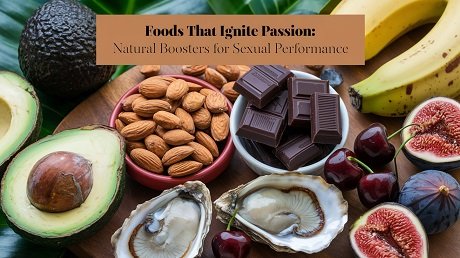The Aphrodisiac Effect: How Food Can Transform Your Love Life
Food has long been associated with romance, passion, and intimacy. The concept of aphrodisiacs—substances believed to enhance sexual desire or pleasure—dates back to ancient civilizations. From the sumptuous feasts of ancient Rome to the exotic spices of the Far East, certain foods have earned a reputation for their ability to ignite passion and improve love lives. This article delves into the fascinating world of aphrodisiac foods, exploring their historical significance, scientific basis, and practical applications in enhancing intimacy and romance.
The Historical Significance of Aphrodisiacs
For centuries, various cultures have celebrated specific foods for their purported aphrodisiac qualities. Ancient Greeks worshipped the goddess Aphrodite, associating her with love and beauty, and believed that certain foods could invoke her blessings. Oysters, for instance, were favored for their resemblance to female genitalia and their rich nutrient profile, thought to enhance fertility and libido.
In ancient China, traditional medicine recognized the power of certain ingredients to boost sexual energy. Ginseng and longan fruit were commonly used to increase vitality and passion. Similarly, the Aztecs revered chocolate, believing it to be a gift from the gods that could invigorate the senses and enhance sexual pleasure.
These cultural beliefs, while steeped in tradition, have continued to influence modern culinary practices. Today, many people still turn to specific foods when seeking to enhance their romantic encounters or simply to enjoy a more intimate dining experience with a partner.
The Science Behind Aphrodisiacs
While many aphrodisiac foods are steeped in folklore and tradition, scientific research has begun to shed light on the physiological effects of these ingredients. The relationship between food and libido can be attributed to several factors, including the nutritional content of certain foods, their effects on hormone levels, and even their impact on mood.
Nutrients and Hormones
Certain vitamins and minerals play crucial roles in sexual health. For instance, zinc is vital for testosterone production, a hormone closely linked to sexual desire in both men and women. Foods rich in zinc, such as oysters, red meat, and pumpkin seeds, can potentially enhance libido by supporting hormonal balance.
Additionally, omega-3 fatty acids, found in fatty fish like salmon and nuts, contribute to cardiovascular health, improving blood flow and potentially enhancing sexual function. A well-functioning circulatory system is essential for arousal, making these foods beneficial for intimacy.
The Role of Mood and Sensory Experience
Food can also significantly influence mood. The experience of sharing a meal can foster connection and intimacy, especially when prepared with care and attention. Certain foods contain compounds that stimulate the release of endorphins and other feel-good hormones. Chocolate, for example, contains phenylethylamine, which can elevate mood and create feelings of excitement and attraction.
Moreover, the sensory aspects of food—its aroma, texture, and presentation—can play a vital role in enhancing the romantic experience. A beautifully arranged plate of fresh strawberries drizzled with chocolate may not only appeal to the palate but also trigger romantic feelings through its visual and olfactory stimulation.
Top Aphrodisiac Foods to Consider
While the list of potential aphrodisiac foods is extensive, some stand out for their historical significance, nutritional value, and sensory allure. Incorporating these foods into your diet can be a delightful way to enhance your love life.
Oysters
As perhaps the most famous aphrodisiac, oysters are packed with zinc, making them a powerful food for boosting testosterone levels. Their unique texture and briny flavor make them a luxurious addition to any romantic dinner. Serving oysters on the half shell with a drizzle of lemon or a mignonette sauce can create an intimate dining experience that sets the mood.
Dark Chocolate
Rich in antioxidants, dark chocolate has been linked to increased levels of serotonin and dopamine, hormones associated with pleasure and happiness. Its creamy texture and rich flavor make it a perfect dessert for a romantic evening. Consider pairing dark chocolate with fruits such as strawberries or bananas, both of which have their own aphrodisiac properties.
Chili Peppers
Chili peppers contain capsaicin, a compound that can increase heart rate and trigger the release of endorphins. This stimulating effect can create a sense of excitement and energy. Incorporating spicy dishes into your meals can not only add flavor but also ignite passion. Think spicy stir-fries or salsas that can be shared and savored together.
Nuts and Seeds
Almonds, walnuts, and pumpkin seeds are often considered symbols of fertility and are rich in nutrients that can support sexual health. Almonds, in particular, are high in vitamin E, which is essential for hormone production. A charcuterie board featuring a variety of nuts and seeds can be a fun and interactive way to enjoy these aphrodisiac foods.
Fruits
Certain fruits are known for their aphrodisiac properties. For instance, strawberries symbolize love and romance, while bananas are rich in potassium and bromelain, both of which can boost libido. Incorporating these fruits into breakfast or dessert can add a playful and sensual touch to your meal.
Creating an Aphrodisiac-Inspired Meal
When planning a romantic dinner, consider how to combine various aphrodisiac foods into a cohesive meal. Start with an appetizer of oysters on the half shell or a salad featuring arugula, known for its peppery flavor and reputation as an aphrodisiac. Follow this with a main course that includes spicy chili peppers, paired with a protein source rich in zinc, such as grilled salmon or a lean steak.
For dessert, indulge in dark chocolate-covered strawberries or a warm chocolate fondue, encouraging a shared experience that enhances intimacy. Pair the meal with a fine wine, such as a red wine known for its heart-healthy properties, to elevate the dining experience further.
The Importance of Atmosphere
Creating the right atmosphere is essential when it comes to enhancing the aphrodisiac effect of food. Consider the following elements to set the stage:
Lighting
Soft, dim lighting can create a warm and inviting ambiance. Candles are particularly effective in adding a romantic touch, casting a gentle glow that enhances the overall dining experience.
Music
A carefully curated playlist can significantly influence the mood. Choose music that is soft, melodic, and perhaps even romantic. The right tunes can create a relaxing environment that encourages intimacy and connection.
Presentation
The way food is presented can greatly affect how it is perceived. Invest time in arranging the meal aesthetically, using colorful ingredients and elegant plating techniques. A visually appealing dish not only stimulates the senses but also shows thoughtfulness and care.
Mindfulness and Connection
Beyond the food itself, the experience of dining together provides an opportunity for connection and intimacy. Practice mindfulness during the meal, focusing on the flavors, textures, and aromas. Engage in conversation, share stories, and express appreciation for each other. This level of attentiveness can deepen emotional bonds and enhance the overall experience.
Conclusion
The aphrodisiac effect of food is a captivating interplay of history, science, and personal experience. While certain foods have long been celebrated for their ability to boost libido and enhance intimacy, the true power lies in how we engage with them. By thoughtfully incorporating aphrodisiac ingredients into meals and creating a romantic atmosphere, couples can transform their dining experiences into opportunities for connection and passion.
Whether you choose oysters, dark chocolate, or spicy dishes, the key is to savor the moment together. Embrace the sensory experience of food, allowing it to serve as a conduit for love and intimacy. Ultimately, the aphrodisiac effect is not just about the food itself; it’s about the shared experience that can rekindle the spark and deepen the bonds of love.












